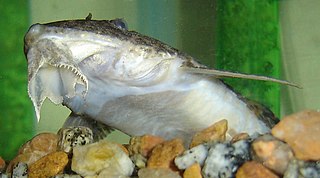
The Claroteidae are a family of catfish found in Africa. This family was separated from Bagridae. However, the monophyly of the family is sometimes contested.

Loricariidae is the largest family of catfish, with 92 genera and just over 680 species to date, with new species being described each year. Loricariids originate from freshwater habitats of Costa Rica, Panama, and tropical and subtropical South America. These fish are noted for the bony plates covering their bodies and their suckermouths. Several genera are sold as "plecos", notably the suckermouth catfish, Hypostomus plecostomus, and are popular as aquarium fish.

Clarias is a genus of catfishes of the family Clariidae, the airbreathing catfishes. The name is derived from the Greek chlaros, which means lively, in reference to the ability of the fish to live for a long time out of water.

The Bagridae are a family of catfish that are native to Africa (Bagrus) and Asia from Japan to Borneo. It includes about 245 species. These fish are commonly known as naked catfishes or bagrid catfishes.

Rineloricaria is a genus of freshwater tropical catfish belonging to the family Loricariidae. They are commonly called whiptail catfish because of the long filament that grows out of the tip of the caudal fin that is characteristic of the genus. With the exception of R. altipinnis from Panama, they are native to the rivers of northern and central South America. Some species are regularly seen in the aquarium trade.

Synodontis is the largest genus of mochokid catfishes. It is the biggest genus within the 10 genera and 190 different species in the family Mochokidae. Synodontis has over 131 different species within the genera. Synodontis are also known as squeakers, due to their ability to make stridulatory sounds through their pectoral fin spines when handled or disturbed. Synodontis make a sound that sounds like squeaking by rubbing their spines together. They do this when they have been frightened or when they become angry. Synodontis may also squeak when they are taken out of the water. These catfish are small- to medium-sized fish with many species exhibiting attractive spotted markings. Some species are also known for naturally swimming belly-up, earning the name upside-down catfish. Some of these species are Synodontis contractus and Synodontis nigriventris. While some of these species are known to swim upside down, another species, Synodontis multipunctatus, is a brood parasitic cuckoo catfish.

Bagrus is a genus of bagrid catfishes. These are relatively large catfished found in freshwater habitats in Africa, except for the virtually unknown B. tucumanus from South America, which likely is a synonym of Luciopimelodus pati.
Pseudomystus is a genus of catfishes of the family Bagridae.

Loricaria is a genus of armored catfish native to South America.

Liobagrus is a genus of catfishes of the family Amblycipitidae. Liobagrus fishes are distributed in the Yangtze River basin, Taiwan, Japan, and the Korea Peninsula. The adipose fin of these fishes is a confluent with the caudal fin. The nostrils are far apart, unlike those found in Amblyceps. Most Liobagrus species grow to about 100 millimetres (3.94 in) SL.

Cathorops is a genus of catfishes in the family Ariidae found in the Atlantic and Pacific Oceans. These species are found in the eastern and western Central and South America in brackish and freshwater habitats. This genus is a strongly supported clade of this family. It consists of a natural group in which the monophyly is well-defined by morphological and molecular evidence and the genus probably includes several unrecognized species from both American coasts.

Chiloglanis is a genus of upside-down catfishes native to Africa. These species have modified lips and barbels that form a suckermouth. They also have a naked (scaleless) body. Sexual dimorphism has been reported in Chiloglanis. The adult males of many of these species have elongate anal and caudal fins. Also, males may have an enlarged humeral process.

Distichodus is a genus of freshwater fish in the family Distichodontidae found in Africa.

Phractura is a genus of loach catfishes that occur in Africa.

Arius is a genus of catfishes of the family Ariidae. The genus Arius is distributed in brackish and fresh waters of Eastern Africa and south to Southeast Asia.
Notoglanidium depierrei is a species of catfish family Claroteidae. This species is endemic to Cameroon where it is known only from its type locality of the Sanaga River Basin. It reaches a length of about 17.2 centimetres (6.8 in) SL. It was formerly considered to be the sole member of the monotypic genus Platyglanis but this has now been synonymised with Notoglanidium.

Parauchenoglanis is a genus of claroteid catfishes native to Africa.

Auchenoglanis is a genus of relatively large, up to 70 cm (2.3 ft) SL, claroteid catfishes native to various freshwater habitats in Africa.

Panaqolus is a genus of small catfish in the family Loricariidae native to rivers in tropical South America.
Synodontis carineae is a species of upside-down catfish endemic to the Republic of the Congo, where it is only known from the Kouilou-Niari basin. This species grows to a length of 14.7 centimetres (5.8 in) SL.

















